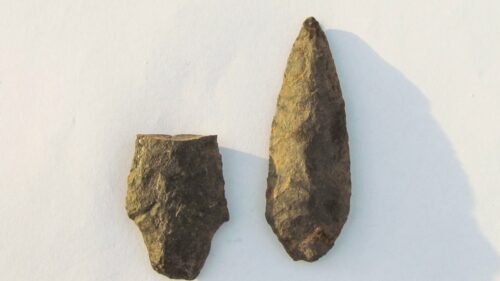February 14, 2019
FOR IMMEDIATE RELEASE: Significant Archaeological Finding Pauses CGL Work on Unist’ot’en Territory
On February 13th, 2019, two stone tools were recovered from the construction site of Coastal GasLink Pipeline Ltd.’s (CGL) proposed mancamp, Site 9A, marking a significant archaeological discovery that indicates a longstanding and continued tie between Wet’suwet’en people and their ancestral territories. Coastal GasLink is legally obligated to stop work in order for a full archaeological assessment to be conducted.
Presently, Coastal GasLink has paused work on this archaeological site, but has not indicated to the Unist’ot’en if they intend to cease work until they are compliant with existing Canadian laws.
In the absence of an adequate Archaeological Impact Assessment (AIA), and continued breaches of the conditions of Coastal GasLink’s permits, the Unist’ot’en clan has been combing Site 9A for evidence of cultural use. This is made possible by the heavy machinery turning up the forest floor and exposing potential archaeological features and artifacts.
Two Unist’ot’en supporters with limited archaeological knowledge conducted a pedestrian survey comprising about a quarter of the worksite. A complete biface stone tool was recovered alongside a partial base fragment of a stem point. Archaeologists from the Smithsonian Institution, Dr. Chelsey G. Armstrong and her colleagues as well as Dr. Chris Springer estimate that the stem point is likely associated with the Shuswap Horizon dating between 3500-2400 years before present.
Additional stone tools at the site were observed and recorded, but the scale and scope of the necessary archaeological work requires the assistance of professional archaeologists. Other archaeological features and artifacts associated with the production and/or usage of stone tools (e.g., flake debitage) are most likely located in the vicinity site but are unidentifiable without the proper training, equipment, time and opportunity to shovel test and/or excavate.
The discovery of these stone tools reaffirms Unist’ot’en knowledge and oral history, which indicate this site as being one of prior significant occupancy. Further testing and research must be done to determine the density of artifacts and features in proximity of the proposed CGL development. Such research could reveal the temporality of occupancy, size of potential settlements and/or hunting camps, types of activities associated with the site, possibility of being a burial site containing human remains as well as numerous other potential findings.
Wet’suwet’en culture and ‘Anuc niwh’it’ën (Wet’suwet’en Law) is inextricably derived from our relationship to our yintah (traditional territories), and our historic and continued use of our territories. These cultural sites and artifacts must be preserved and could provide material evidence to oral history, furthering our understanding of how ‘Anuc niwh’it’ën was lived on our yintah by our ancestors. These artifacts could demonstrate how the Wet’suwet’en controlled access to our yintah and enforced trespass, and provide evidence of continued use and occupation through many generations.
Coastal GasLink has shown that their desktop study (termed “Archaeological Overview Assessment”) has been completed remotely and does not involve the gathering of any archaeological information on the ground. This is not synonymous with a Archaeological Impact Assessment, and CGL has relied on the lack of clear definitions around AIA requirements to sidestep responsible archaeological practices. Their injunction application affidavits indicate that no site investigation or fieldwork was completed at the site prior to construction, as required under the terms of their BCOGC and EAO permits. The area was bulldozed and excavated without an archaeologist ever having set foot on site. Surveys conducted by CGL contractors and employees have proven inadequate, given that the company bulldozed multiple traps before realizing there was a trapline on their proposed construction site.
Under section 13(2) of the Heritage Conservation Act, administered by the Ministry of Forests, Lands, and Natural Resource Operations, Coastal GasLink must not “damage, excavate, dig in or alter, or remove any heritage object from, a site that contains artifacts, features, materials or other physical evidence of human habitation or use before 1846” OR from “a site that contains artifacts, features, materials or other physical evidence of unknown origin.” The Heritage Conservation Act is binding on the government, and overrides any other conflicting Act. It protects heritage sites pre-dating 1846 AD, and requires Coastal GasLink, as the BCOGC and EAO permit holder, to cease all work immediately.
The Heritage Conservation Act falls under the jurisdiction of the Archaeology Branch of the Ministry of Forests, Lands, and Natural Resource Operations. Should Coastal GasLink fail to comply with the Act as detailed in their Environmental Assessment Certificate and BCOGC permits, we call on the Minister, Hon. Doug Donaldson, to issue a stop work order under Section 16. If work continues in this area, it will continue to cause irreparable harm to Wet’suwet’en cultural heritage and our longstanding land-based traditions. Responsibility for this damage lies with Coastal GasLink, complicit RCMP observers, and the Provincial government.
The Unist’ot’en have made it clear that this area has been occupied and used continuously by Wet’suwet’en since time immemorial, up until Coastal GasLink bulldozed our trapline in the first stages of clearing the site. This oral tradition has now been reaffirmed with material evidence.
We call upon all relevant authorities to immediately stop all work in this area. Permitting any further industrial activity would constitute a clear violation of both Wet’suwet’en and Canadian law.
Media Contact:
tsewedielh@gmail.com
Freda Huson, Spokesperson
Dark House – Unist’ot’en



